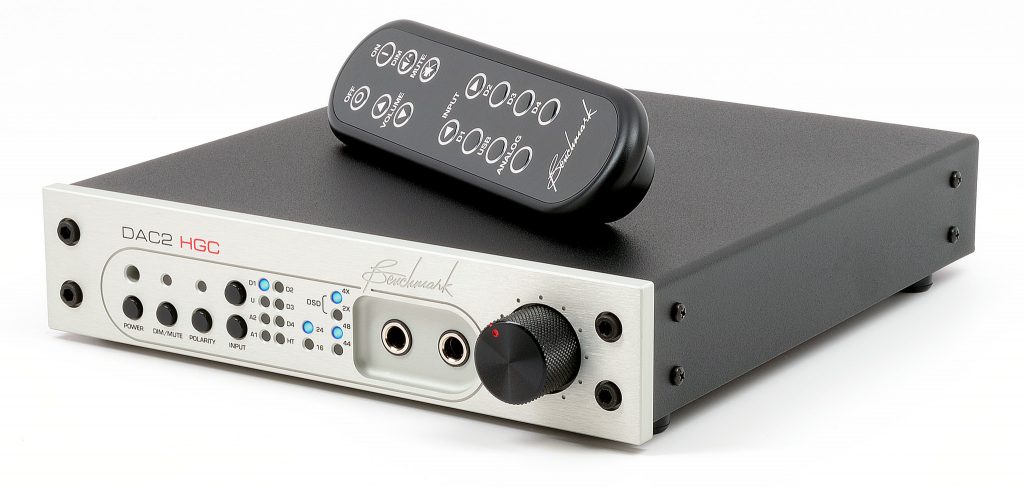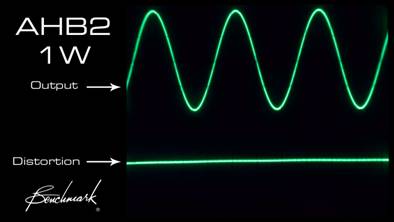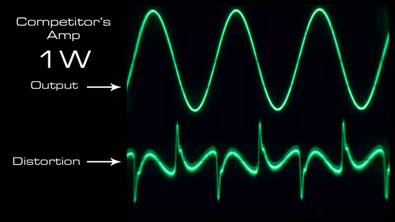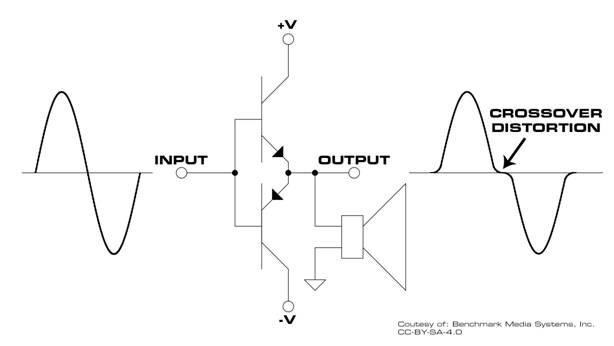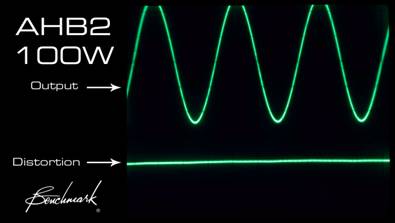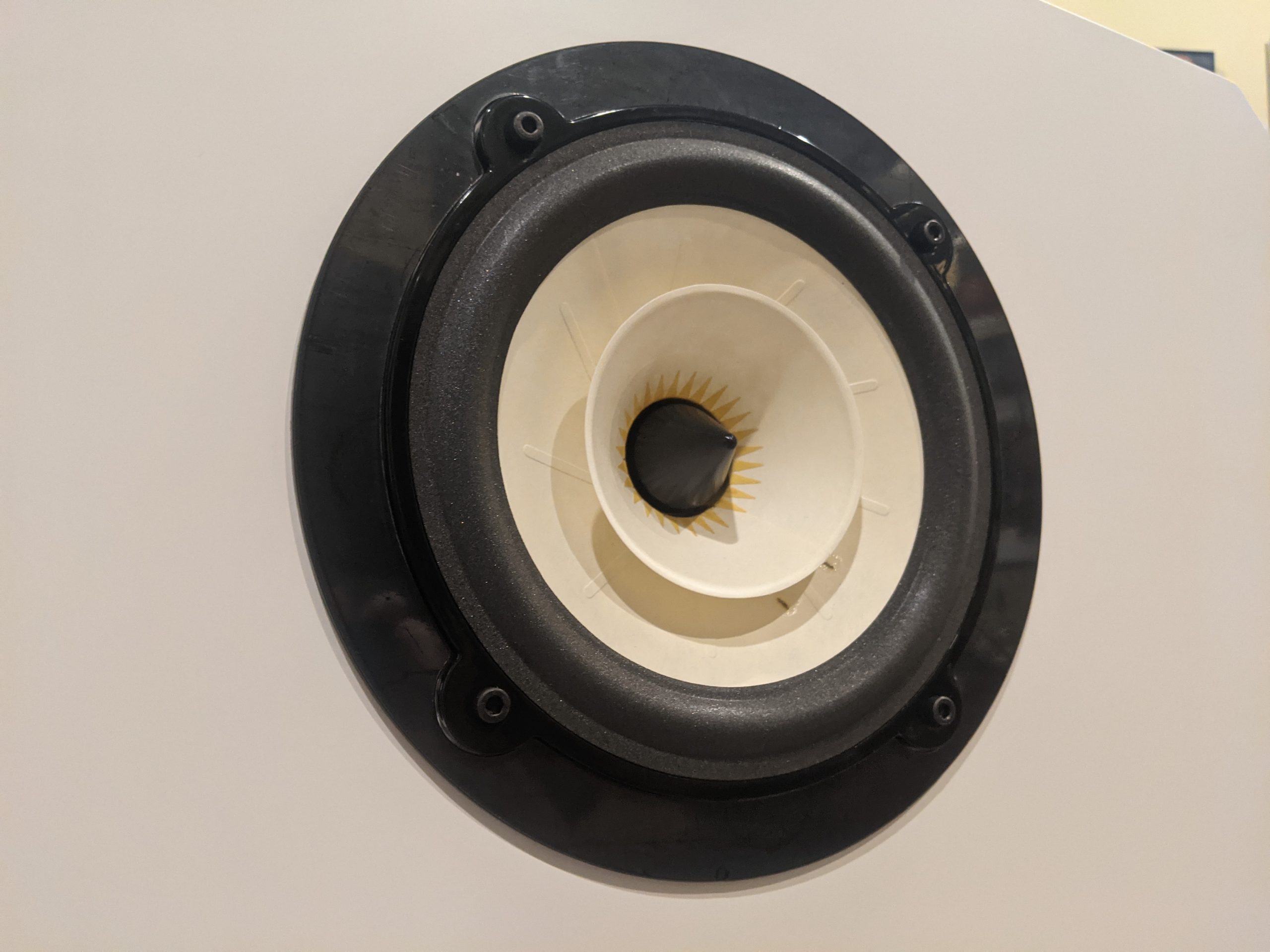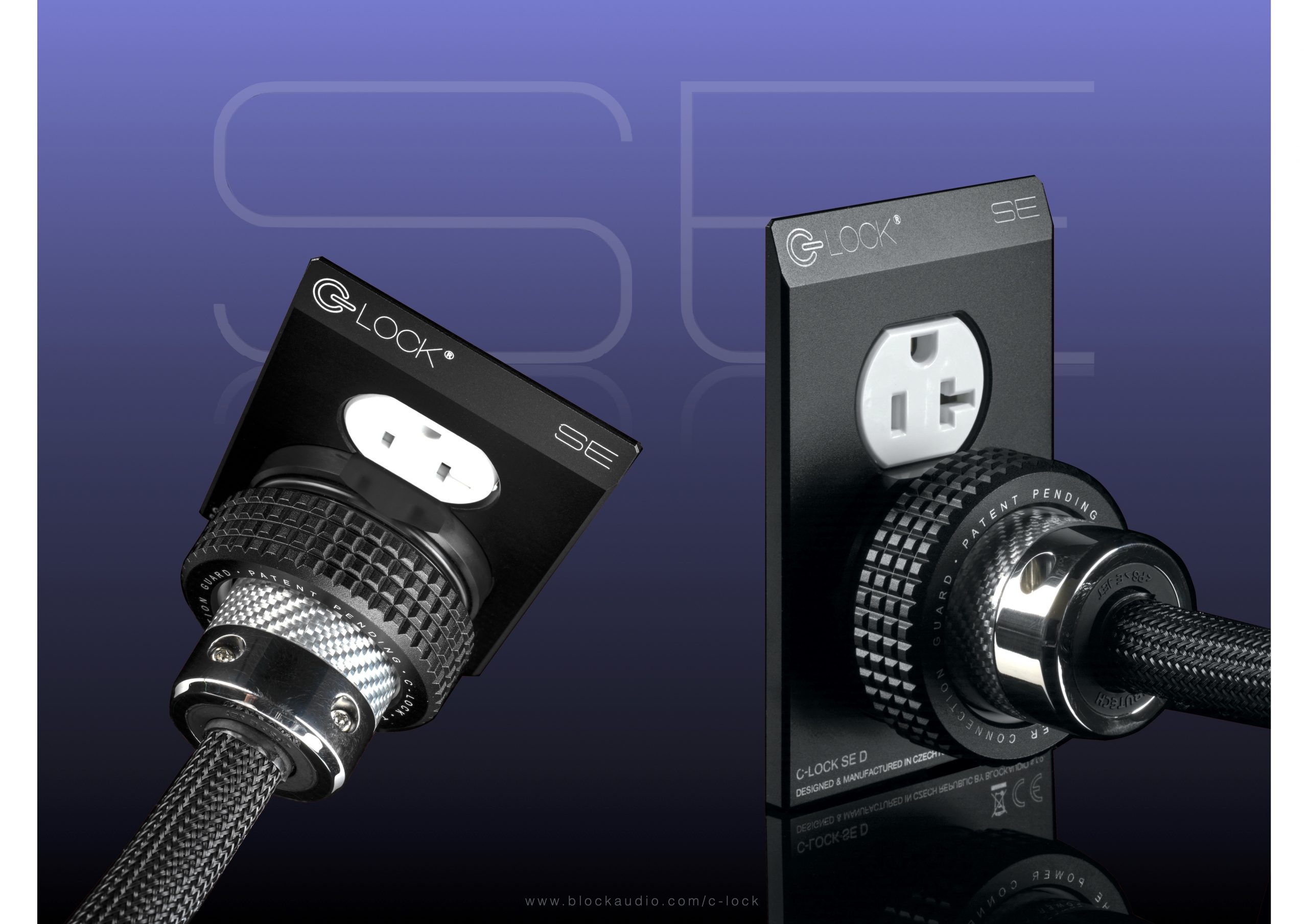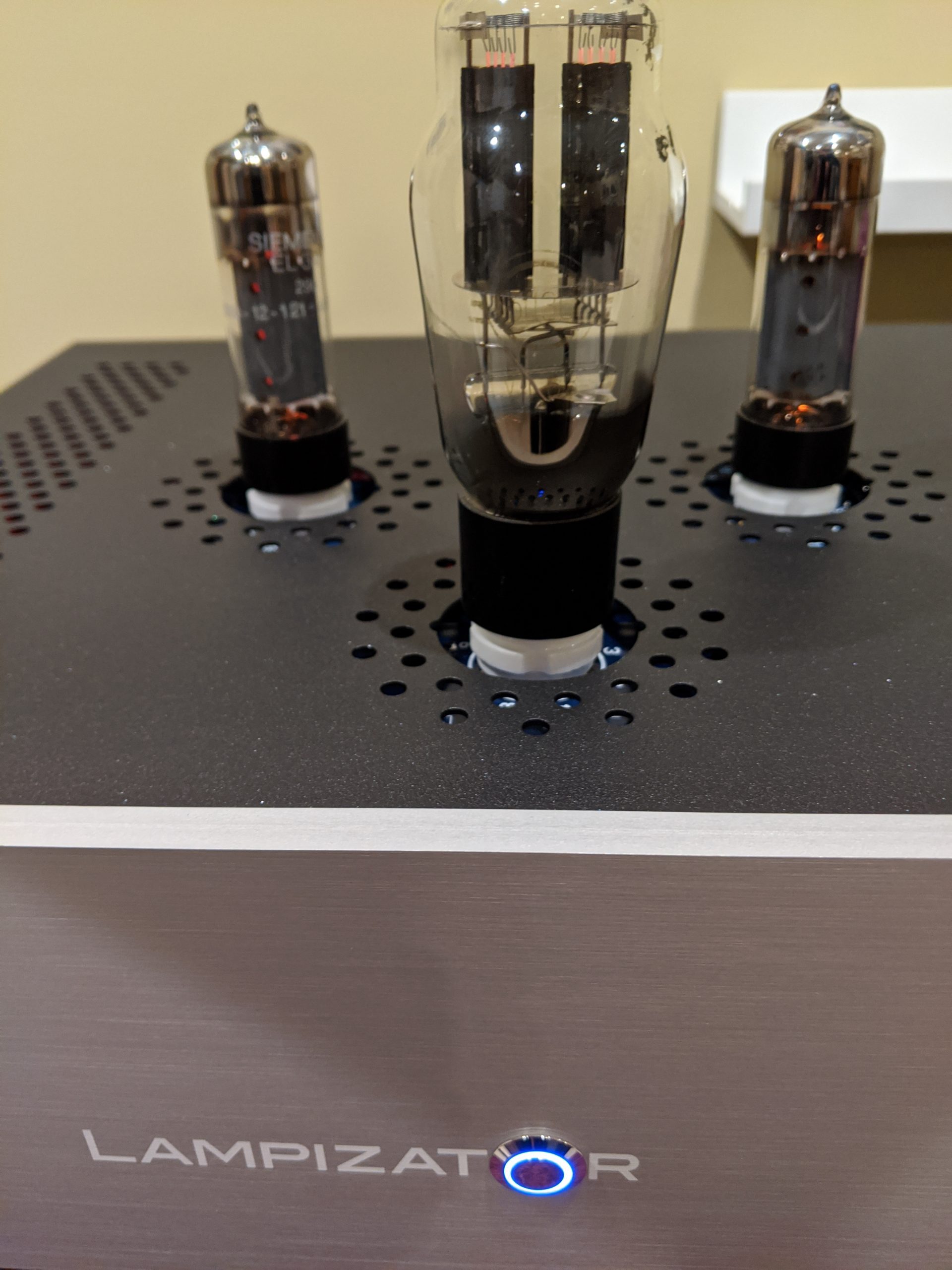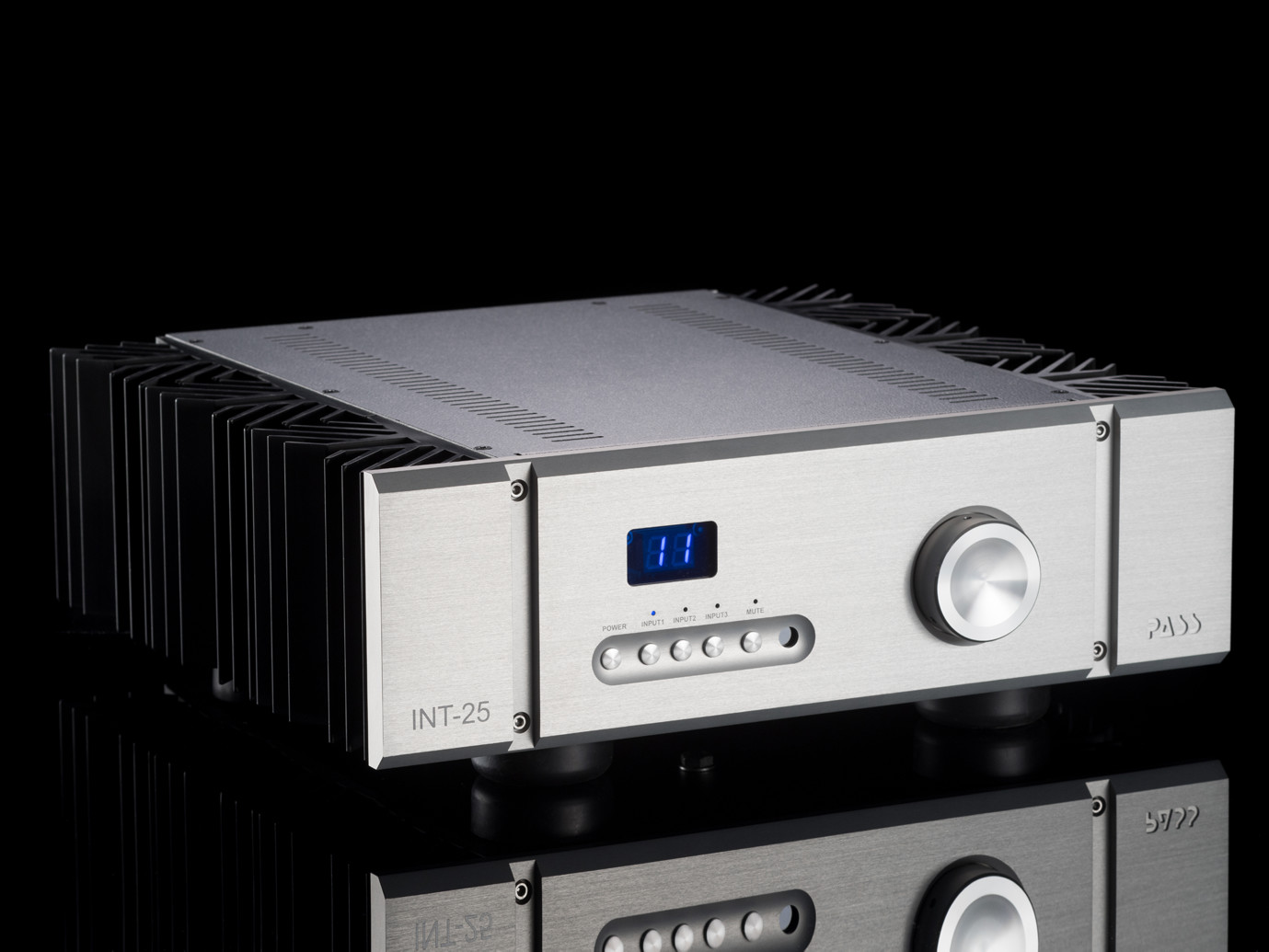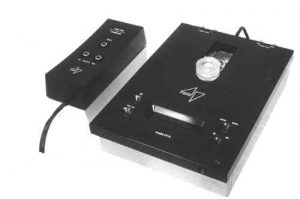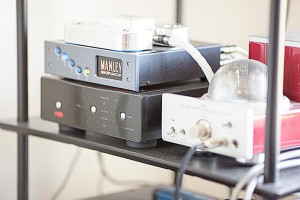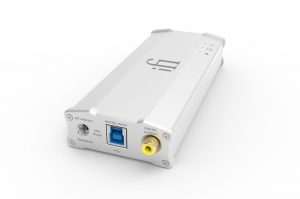For a number of months, I've been jamming to the sounds of the Benchmark Media Systems DAC2 HGC D/A converter and AHB2 stereo amplifier. While a bit late to the review party; I am anything but a groomsman, because listening to this gear is the ultimate reward for my time. BM builds serious professional equipment; and because a "traditional" examination of them could end up reading like an op manual, I've decided to forego the comprehensive recitation of input nuts and output bolts and just go for it. One could accuse me of being lazy (I am), but in reality, it's because I've got far more important things to say, like (in this article's context), BM is short for Benchmark.
Heh.
Because it is central to the story of the AHB2 amp—which is named in honor of Benchmark's founder, the late Allen H. Burdick—at the conclusion of my comments, I have included a short interview with Benchmark V.P. and Director of Engineering, John Saiu, to give Positive Feedback readers a glimpse into the thought leadership behind these finely-crafted audio components. It is an interesting read worthy of your time.
Achromatically Distortion-less?
Benchmark Media Systems Pro-centric products tout exceptional specifications, and their AHB2 amplifier--developed in tandem with engineers from THX and using their patented HX Achromatic™ Audio Amplifier technology—uses some rather unusual patented designs to get to those remarkable spec numbers. Personally, I do not subscribe to the "specs are everything" idiom, nor do I believe that just because a uniquely designed piece of gear uses a phalanx of "new" circuit methodologies that cross against the grain of normal, they are somehow better or worse than everything else available.
Alrighty then, let's get a few rudiments out of the way.
The Benchmark AHB2 is a very good amp, and the DAC2 is a very good DAC—it's no wonder that they have been slathered in near-universal praise. Between the two, there is a dizzying array of protective circuits, connections, and set-up choices; and both have been engineered to replay the truth and nutin' but the truth. And when discussing the two as a system, the Law of Diminishing Returns quickly comes into play, as these two partners in musical misbehavior sound great together and cost less--with Benchmark cables included—than my Pass XA 30.8 amp alone. To be sure, my reference Pass is a fantastic amplifier, but the AHB2 has its own charms that I found played to my own listening biases.
Debating the Candidates
I suppose if I was pushed in a debate, I would say, of the two pieces, I like the DAC2 HGC the best on its own. Its vast array of connection options and terrific sound makes it a standout in its price class. I do wish it had a numeric volume display, or even a simple position LED on the volume control knob, and while we're at it, a backlit handset would be cool, however, it is hard to fault its resolute sound, and high degree of functionality. That said, the AHB2 amp is also an amazing performer, and I only choose the DAC ahead of the amp because, while certainly versatile, the AHB2's lack of unbalanced inputs, and somewhat restricted speaker posts, do require adapters for our unbalanced and big-spaded audio friends. But that does not tell the whole story. Speaking strictly of sound quality in a balanced configuration, the AHB2 is one of the most striking components I've ever heard.
[Sidebar: Benchmark Sales Manager, Rory Rall, sent a complete suite of BM cables to use during the review. XLR to XLR for connection between the DAC and amp, Speakon to Banana speaker cables, and XLR to RCA cables to connect single-ended sources to the AHB2. These well-made cables are assembled from products manufactured by Canare and Neutrik, and they work very well, and sound very good; kudos to Benchmark for these outstanding, and affordable cables.]
The Tiny Amp Movement
Pushing out 100 watt/channel into 8 ohms, the AHB2 is a tiny dynamo—a Tinamo!—with features like switchable gain and connections to allow the use of a second amp in bridged mono (380 watt/ch!), and vertical bi-amp configurations. I love the satisfying "click" of the Neutrik Speakon speaker connections, which (with the exception of my REL sub) are unique in my experience with home hi-fi gear. I spent 90% of the time using BM's cables, so all my comments on sound quality are with them in the chain; and honestly, if I owned this gear, I would happily use these cables and never look back.
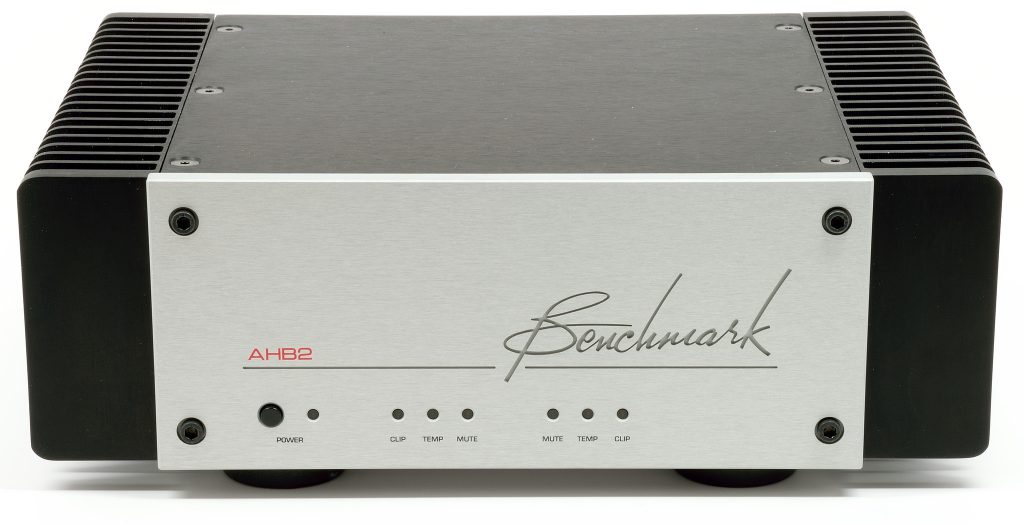
The AHB2's performance is a real eye-opener. It is not romantic by any stretch, but certainly not cold or sterile either. However, if you don't like hearing recordings in all their glory, then this amp may not be for you. Yes, the AHB2 is exacting, and because it is tremendously detailed, it tells you everything. Music appears in stark relief, and inner-resolution with the DAC2 HGC as the source was simply terrific. I used to think I liked to be lied to just a little while listening, so the highest level of recording accuracy has not been what I've pursued, but within the AHB2's version of the truth, there is so much beauty that musical honesty might indeed, be the best policy after all.
Damn hard to fault that conclusion, but it took a while to get there…
As the Benchmark system settled into its temporary home, it didn't so much blossom, as crawled its way into my psyche. I liked it from the beginning, but kept thinking that somehow, I just hadn't picked up on its shortcomings. It was almost like I was trying to not to like it. But with each listening session, I found more to love about the Benchmark presentation, especially the duet as a team. DSD playback was especially well treated and I thoroughly enjoyed playing selections such as Brahms: "Symphony No. 4 in E Minor, Op. 98", by Bruno Walter & The Columbia Symphony Orchestra. I had never heard this piece sound so good. In fact, all DSD selections sounded spectacular through the DAC2, and unlike my Sony HAP-Z1ES which upsamples to DSD, there was a marked difference between PCM and DSD. Further listening revealed the AHB2 to be a tremendous performer at low volumes. I did not find this to be true in the early going, but once I learned to keep my finger off the "up" volume button (easy to do with this quiet combo), I quickly started to notice how deftly it reconstructed music from all the itty-bitty details, while not needing 90dB peaks to do so. When listening to Lionel Loueke's "Tribal Dance" at very low volume, I noted how the percussive elements and hushed cymbals came out of nowhere, in space, in stage, all while barely turned up.
The DAC2 HGC and the AHB2 form a sonic alliance that could well be a hi-fi endgame for many. So small, so green, so simple and clean, yet at the same time, high value complexity: Plug in your USB, digital input from a streamer or CD player, connect the phonostage, slam in the 1/4" headphone plug, and tie the bass drum to your shoe... your personal two-man-audio-band beckons. I won't pull a fast one on you here, I did play both pieces with my personal gear and others, but once I heard them together, I spent the majority of the time listening in that arrangement.
The BM System as a Control Center
Having determined the DAC/amp to be quite the digital extravaganza, the next thing to determine was whether the DAC2 HGC would shine as an analog preamp, so I connected my Music Hall MMF-9 and Wright Sound phono stage through one of the two analog inputs of the HGC, and my Sony HAP-Z1ES through the other. The phono didn't sound quite as smooth, but resolution, depth, and impact were very good. It was a smidgen less dimensional, and there was a slight loss of transparency in comparison to my passive Bent Audio AVC-1. The slight harshness did vanish after a bit, and vinyl playback certainly sounded far better to me than I expected. The DAC2 HGC's analog linestage surprised me with its ability to get out of the way, and when running my Sony HAP through it, I was quite happy with its performance—enough that I consider it a proper analog preamp—remembering of course, that is it tough to be all things to all people. That stated, I would be remiss if I didn't mention the DAC2 HGC's built-in headphone amplifier. It features two ¼" jacks, one that shuts off the speakers when in use and one that does not. I am not a big headphone user these days, so I ask for a pass on how it compares to the best out there, but I cannot imagine most casual audiophile users being less than thrilled with the sound. It was meant for audio engineers after all!
The Sound of Two Benchmarks
Listening to the BM system gave me many goosebump moments with its rhythmic drive and transparency to the source. The pair display excellent treble extension, wonderful midrange, and deep, well controlled bass. The presentation is spot-lit, precise, even delicate at times. I've often heard the term "lit-up" used to describe the sound of audio components—the BM system has this wonderful quality. I suppose this is a result of a very resolving upper-midrange, because I do not detect any unnatural boost of this "presence" range. The system, and especially the AHB2, is very dynamic—and there is a lithe airy quality to the amp too—until hammer comes down. Boom boom, baby… take that, says Stanley Jordan! There is incredible separation of instruments and voices, and the system is so quiet, at times, on older stereo material, it seemed as if only one speaker was hooked up! The DAC2 HGC is not quite as dimensional as some DACs I've heard, but depth is quite good, and staging is wall to wall. Here is the best part; the AHB2 and DAC2 HGC convey naturalness that is unexpected, with subtle harmonic overtones that make music and voices come alive. They both have a musical presence that never failed to pull me in to the musical story, causing abrupt outbursts of enthusiastic, yet ill-advised, singing.
Yep. Good stuff, those BM boys.
DAC2 HGC and Pass XA 30.8
Pairing the DAC2 HGC with the Pass XA-30.8 via XLR, presented a distinct tonal shift to weight—the leaner AHB2 to the relative fullness of the Pass. It was very strange at first, as I had become accustomed to the lighter, brighter presentation of the Benchmark amp; but there was a general sense of "more" with the 30.8. The AHB2 excels in its precise highlighting of the stage, and provided more pointed detail, and speed, while the Pass is more layered, enveloping and visceral. Both, however, have serious wow factor, so if you're looking to spend significantly less than the Pass, you must check out the AHB2.
Preamps, driving the AHB2 Bus:
I tried driving the AHB2 with both the Atma-Sphere UV-1 Ultraviolet Preamp and my own Bent AVC-1, using the BM RCA to XLRM (Pin 3 to Shield) cables to make the single-ended connection. The AHB2's sensitivity switch was a welcomed function when using the unbalanced inputs; the UV-1 requiring the switch to be in the middle sensitivity position of 17dB, while the passive Bent, needed the highest gain setting of 23dB. What a joy it is to have the option to select the gain!
The Bent AVC sounds damn good with almost everything it's paired with, but I never felt it sounded as good with the AHB2 as did the DAC2 direct, and I just couldn't get that out of my head. So, while the AVC-1 may not have gelled, the Atma-Sphere was fantastic. The UV-1 preamp was quiet as a church mouse driving the AHB2 using the DAC2 as the source, the adjustable gain of the BM allowing for a much better gain structure with the UV-1 than did the XA 30.8. The tube magic of the Ultraviolet was put on full display and even the phonostage, which I thought was tilted up a bit too much for my taste, really came into its own. I always use Joe Jackson's Body and Soul for one of my review LP's; it is a well recorded, terrific performance, and the UV-1's did it proud, with beautifully poignant music. Damn, I love that record… with the (also tiny) Ultraviolet in the chain, the sound was tonally weightier, slightly darker, and richer. It was very smooth and removed any hint of the leanness I'd heard in the AHB2. The tone of McVie's piano on Fleetwood Mac's "Songbird" was lovely and even early 1960's recordings like Shelly Fabares' "Johnny Angel" proved an easy listen. Speed may have slipped a notch, but resolution (with the DAC2 HGC providing the tunes) remained high. Once in a great while, a motley crew of electronic circuits comes together to form a partnership of sonic love. The strengths of the DAC2 HGC, AHB2, and the UV-1 immediately crystallized into a wondrous mix of aural splendor, with power, finesse, a huge stage, and excellent resolution. There is only one word for the result: Music!
The DAC2 HGC is Value Personified
I connected the Sony through the DAC2's preamp section to (unscientifically) compare the two DACs. The DAC2 HGC is more detailed, and exciting. The HAP is smoother and more relaxed. They both play nearly every audio file format available, but differences between formats are more readily apparent with the BM. Curiously, when compared directly in an A/B switcheroo, the sonic differences between these DACs did not seem all that great. That might sound like a demerit for the DAC2, but I assure you, the HAP-Z1ES is a terrific performer, so it really a fine complement to the BM. Where the DAC2 HGC really takes the lead over the HAP is in its incredible versatility. The BM elevated the sound quality of my Sony DVP-7700 DVD player to new heights via its Coax optical input. I also connected a Chromecast Audio dongle, as well as Audioengine HD6 powered speakers through the DAC2 HGC using both Toslink and analog connections, and wow, what good sound! The HD6's especially shined, with dynamic jump and much deeper bass than with any other source I'd used. Even crappy recordings were curiously very listenable. The HGC is a lot more than a damn good DAC, but if all you buy it for is its ability to convert digital to analog, I'm betting you'll still be a very happy listener.
Conclusion?
Before I put two really big thumbs up, here are a few final thoughts, straight from my listening notes:
Things I Didn't Love:
Somewhat difficult to use Speaker Posts
The Remote was hard to use in the dark
Accidentally set the Mute volume too high once. Whoops!
Very hard to see the volume setting from seated position
Things I Loved:
Dynamo Slam
Sneaky Bass Monster
Intelligibility
Engaging midrange
Tonal texture
Small form factor
DSD Playback
Speedy Transients
Bell-like clarity
Incredible S/N
Pretty much everything about the sound!
I could, and perhaps even should, live happily ever-after with an all Benchmark Media System, cables and all. As it has been said, love is a many spend-ored thing, and being a gearhead in addition to a music lover, I'd have to invest in a second AHB2. I mean, come on, love means never having to say you're sorry you don't have enough power. Yes, I've enjoyed my time with the DAC2 HGC and AHB2 Stereo Amplifier. Individually, they merit your further investigation. But together, they form the nucleus of a system that is in my experience, one of the best values in high-end audio I've yet heard, and I cannot recommend them highly enough for that reason alone.
Benchmark DAC2 HGC D/A Converter
Retail: $1995 USD
Benchmark AHB2 Power Amplifier
Retail: $2995 USD
Benchmark Media Systems, Inc.
Floor 2
203 East Hampton Place
Syracuse, NY 13206 USA
Toll-free: 800-262-4675 (800-BNCHMRK)
An Interview with Benchmark's John Saiu:
GB: Mr. Saiu, there are many locations on your website where readers can find both technical explanations and general overviews of the new technologies used in the AHB2 amplifier. I suspect many audiophiles—including myself—may find much of this information a bit too technical to truly understand the innovations in the AHB2 amplifier. Can you further explain the circuit design, and why it is unique to the world of audio?
JS: Sometimes all of the words and numbers can be confusing. For this reason, we decided to shoot a few photos of the oscilloscope screen on our AP2722 audio test station.
These photos may say more than the many words on our website:
These photos show the output of the AHB2 at 1 Watt, and the output of a typical class-AB amplifier at 1 Watt. The scale factors are identical between the two amplifiers. The distortion waveform is amplified by a factor of 1024 (60dB) so that the distortion can be seen on the scope. The conventional amplifier shows spikes of distortion at every 0 crossing. This crossover distortion is typical of virtually all class-AB amplifiers, but it is not produced by the AHB2.
One key to the performance of the AHB2 is that it uses feed-forward error correction to eliminate crossover distortion. The impulses are too quick to be corrected by a feedback system, but they can be completely removed using a well-designed feed-forward correction system. Feed-forward error correction is not new, but the configuration used in the AHB2 is unique and is covered by two THX patents.
The following diagram shows an amplifier push-pull output stage, with an input and output waveform. The crossover distortion is exaggerated for clarity.
Years ago a reviewer named Dick Osler said "the first Watt is the most important Watt". I agree with his statement. Dick made a strong case for class-A amplifiers because they are free from the push-pull crossover distortion that is produced by virtually all class-AB amplifiers. The scope photos above show that the AHB2 acts like a class-A amplifier in that it has virtually no crossover distortion.
No amplifier delivers cleaner performance in the first Watt than the AHB2! The AHB2 is quieter and cleaner than any other power amplifier on the market. Like a class-A amplifier, the AHB2 is free from crossover distortion. In fact, the AHB2 has less distortion and less noise than any class-A amplifier. These are not just our claims, but a number of reviewers have said the same after measuring the AHB2.
Class-A amplifiers tend to be big, expensive, and very inefficient. In spite of their size, they are often underpowered. They also tend to have low damping factors and this often means that they have poor control over the speakers. These negatives are offset by the fact that crossover distortion is eliminated. Many people consider this a good trade-off because of the importance of the first Watt.
The AHB2 is a game changer because it delivers the primary advantages of class-A amplification without any of the disadvantages. The AHB2 is almost as efficient as a class-D (switching) power amplifier, it has excellent damping, it runs cool and it is very compact. The new technology in the AHB2 eliminates the classic tradeoff between sonic purity and power efficiency.
The performance at maximum rated power is equally impressive. Compare the following two photos:
The first watt photos showed the sharp spikes of distortion that are produced by the push-pull output stage in a typical class-AB output stage. The 100 watt photos show still show some crossover distortion in the class-AB amplifier, but other forms of distortion are beginning to dominate. In this case, a strong (and unmusical) third harmonic is dominating the distortion waveform.
The scope photos can be viewed in a video sequence on our Facebook page:
https://www.facebook.com/benchmarkmediasystems/
GB: Can you enlighten the Positive Feedback readership the human story behind the development of the AHB2 with THX?
JS: About 33 years ago, Benchmark's founder, Allen H. Burdick, began building analog audio distribution amplifiers for television networks. This application demanded an audio amplifier with a very wide frequency response, very low noise, and very low distortion. The Benchmark DA101 distribution amplifier had a 160kHz bandwidth, THD+N of 0.00044%, and a SNR of 130dB, but the power output was only about 35 watts in bridged mono. These amplifiers were designed to simultaneously drive 10 balanced audio lines, and were not originally intended for driving speakers. Nevertheless, they were capable of driving 8-Ohm speakers and, for many years, we used our distribution amplifiers to drive the speakers in our listening room. We couldn't buy an amplifier that came close to the performance of our distribution amplifiers, and Allen had often talked about building a bigger amplifier that could match the performance of the DA101.
Allen retired in 2006 due to health issues, and in 2011 we began to talk about making Allen's dream for a power amp a reality. The goal was to meet or exceed the performance of Allen's DA101 while scaling up the power by a factor of 10. One obstacle was that push-pull crossover distortion can be hard to manage in a large amplifier. We began to look at unconventional solutions to this problem, and had a design in progress by June of 2011. It was to have a switched-mode power supply and a unique servo-biased push-pull output stage. We were going to have to think out of the box if we were going to reach our performance goals.
In November of 2011, I was attending the AES conference and I ran into Laurie Fincham and Jayant Datta, some good friends from THX. We met for lunch and they began to tell me about a new amplifier topology that they were working on. They had applied for patents and were looking to turn their ideas into a product. This was the classic lunch with schematics and numbers scribbled on napkins. We realized that our two companies had complimentary skills that could make a joint project a success. Their patents offered an elegant solution to the crossover-distortion problem and we were already planning to build an unconventional power amplifier with ground-breaking performance. By the time we finished lunch, we had outlined the performance requirements for the new amplifier. These specifications, written on a napkin in 2011, are almost identical to those of the production AHB2.
Much of 2012 was spent testing and improving low-power THX prototypes. The THX team was split between California, New York, Canada, and England, while our team was located at our headquarters in Syracuse, NY. It was an international effort tied together with email, Skype, air travel, and a common love for music and great audio.
In November of 2012 we set the final specifications and coden-amed the project the "PA2". We began the final designs for the casework, circuit boards, and custom transformers. On September 27, 2013, everything was ready, but we still didn't have a name for the new amplifier. The faceplates were machined and finished but needed to be printed with the product name. I began thinking about the technology in the amplifier and how this could be incorporated into the name. The amplifier delivered class-A performance, had class-H tracking rails, and a class-AB output stage. It then struck me that the letters A, H, and B were Allen H. Burdick's initials. Instantly it was clear to me that the new amplifier should be named after the man who inspired it! I announced the name to my staff, and we placed the order for the printing. Less than an hour later we got a phone call with the sad news that Allen had passed away.
In October 2013 we demonstrated the first working AHB2 prototype at the AES show. We then completed a 20-unit pilot run in early 2014, and then spent several months completing compliance and safety testing. By October of 2014 the first production run was nearly ready, and we hoped to take the very first units to the 2014 AES show.
Through heroic efforts, the first production AHB2 was ready just in time for the 2014 AES show, where an amazing coincidence occurred at the 2014 AES show. Through similarly heroic efforts, Audio Precision completed their first production AP555 audio test station just in time for the same show, and they were located in a neighboring booth. AP's last-minute success was important for them because they were planning to celebrate their 30th anniversary on the show floor. They invited us and our new AHB2 to their booth for their 30th anniversary celebration. Top engineers from Audio Precision, THX and Benchmark all gathered around the test station to see AP555 run tests on the AHB2. The group included Laurie Fincham, and Jayant Datta (THX), Bruce Hofer and Tom Kite (AP), and John Siau (Benchmark). Everyone was so impressed by what they saw, that the festivities faded into the background. The AP555 was the best audio test station we had ever seen, and the performance of the AHB2 was pushing the limits of the test station. It was hard to say who was the most excited.
GB: Generally, high-end audiophiles do not like to hear the phrases "Negative Feedback" and "Switch Mode Power Supply". Can you explain how they are used in the AHB2, and what effect they have on sound quality?
JS: It may surprise you that Benchmark has eliminated linear power supplies from all of our products because they are much noisier than a well-designed switch-mode power supply. The operating frequency of a linear supply is always in the audio band (50Hz or 60Hz), and the rectifiers produce strong harmonics of the line frequency that can extend up to at least 400Hz. These frequencies produce the hum and buzz which are all too familiar. In contrast, switching supplies can be set to operate at any frequency desired. We set ours to operate between 200kHz and 1MHz. If these supplies produce interference, it is well above audible frequencies where we can filter it out without impacting the audio. Furthermore, the size of the transformers, and the strength of the magnetic fields that they produce decrease rapidly as the operating frequency increases. For this reason, the AHB2 has very low magnetic emissions and this allows it to be used in close proximity to sensitive audio devices such as phono preamplifiers and microphone preamplifiers. More importantly, the AHB2 power supply board does not interfere with the AHB2 amplifier board even though these boards are less than an inch apart. The 132dB SNR of the AHB2 is evidence that this works! This performance would not have been possible if we had used a linear power supply!
Negative feedback gets a lot of negative press! Feedback is one of the fundamental building blocks of low-distortion audio circuits. Nevertheless it has some limitations. Feedback is very effective at removing low-frequency distortion but it becomes increasingly less effective as the frequency increases. For this reason, feedback is relatively ineffective at removing the high-frequency impulses produced by push-pull crossover distortion in an amplifier output stage. Feedback attempts to correct errors after they start to happen. When the errors happen too quickly, they will not be corrected by the feedback system. Impulse errors (such as those produced by crossover distortion) often interrupt the normal operation of the feedback loop, rendering it useless for a short period of time. For these reasons, the AHB2 uses a feed-forward error correction system to eliminate crossover distortion before it upset a feedback loop or reach the output.
GB: Can you give us some insight into the DAC2 HGC's analog preamp design?
JS: The DAC2 HGC has a hybrid gain control system. Analog inputs pass through an analog volume control, digital inputs pass through a 32-bit digital volume control. This dual-domain system prevents unnecessary conversions and keeps the signal path as clean and pure as possible. The XLR outputs can be configured for full studio levels (22dBu) or they may be padded down by 10 or 20dB to interface with consumer balanced inputs. This is accomplished with low-impedance passive pads on the XLR outputs. These pads preserve the full SNR of the DAC2 when lower output levels are required. This unique feature optimizes the range of the volume control and maximizes the SNR of the entire playback system. The value of this feature should not be underestimated.
GB: The DAC2 HGC and AHB2, work very, very well together. Was that a design consideration when you were developing the AHB2?
JS: When the DAC2 was released, it had a SNR that exceeded that of all existing power amplifiers. Likewise, the distortion produced by the DAC2 was much less than the distortion produced by any available amplifier. The AHB2 was intended to compliment the performance of the DAC2 and eliminate the power amplifier as a weak link in the audio chain. With a DAC2 and an AHB2 the entire electronic chain is truly transparent. This leaves one and only one component as the weak link. This final weak link is the loudspeaker.
GB: Mr. S, are you an audiophile and/or music lover? What type of system do you own and what music moves you to want to design ever-better products?
JS: I am a long-time audiophile. It was my love of music and great audio that led me to study electrical engineering. I have had many different systems over the years but now I have a Benchmark system at home and in my office. At my desk I have a DAC2 HGC, an AHB2, and a pair of SMS1 monitors. In our listening room we have a variety of passive and active monitors, as well as several choices for amplification. The room includes an all-Benchmark 5.1 system. I find that it is important to spend time listening to a variety of systems in order to understand the characteristics of our own system. We have a carefully matched setup that allows accurate comparisons between amplifiers and speakers. This setup includes an ABX tester for amplifier and DAC double-blind testing.
GB: For a very long time, Benchmark has been a fixture in the Professional sound world. And since the introduction of the DAC1, audiophiles have embraced your company as well. Can you fill us in on what might be next on the BM design table?
JS: No!
What I can say is that we will continue to build all of our products to suit the needs of the audio professional. Some of these products will also have audiophile applications.
GB: Mr. S, thank you very much for your time to answer these questions. Benchmark's contributions to fine audio reproduction have been applauded by many; you can now add my name to that list!




